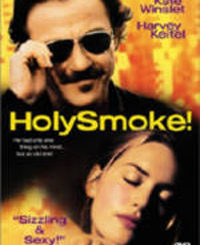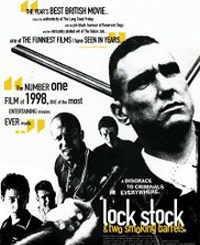Lost Saints and Wayward Sinners (plus that dork who did Pi)
with James French, Isaiah Gallegos, Joe Manuel Gallegos Jr.
Directed by Frederick Aragon, David Ferry Jr.
Written by Kc Mathis
by Adam Haynes
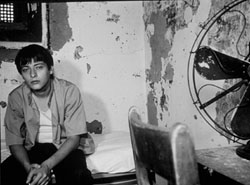 The problem and the strength of the new Edward Bunker movie, Animal Factory, is that it wants to subvert the standard gritty prison drama.
The problem and the strength of the new Edward Bunker movie, Animal Factory, is that it wants to subvert the standard gritty prison drama.
The story’s about a young guy, Ron Decker (played by Edward Furlong) who gets the book thrown at him for a trivial amount of drug dealing. Finding himself in serious lock down, he becomes the friend and pupil of lifer Earl Copen (Willem Dafoe) as a way to survive.
The agenda Bunker bluntly thrusts at us is that it’s the prison system which turns men into criminals, and while there’s nothing new or enlightening about this viewpoint, Bunker’s angle is that the way these prison factories produce these criminal animals isn’t by the usual harshness and evil of prison (though this movie is not without those elements), but through the sheer dumb absurdity of the prison bureaucracy, and the intense boredom it creates, which in turn becomes its main dehumanization device.
Basically, the movie is pretty flat because the screenplay, like the books Bunker’s produced, is basically pulp, lacking integrity or soul, due to Bunker’s ineffectual pretensions toward something more literate. The message of complete moral absurdity Animal Factory serves up is certainly a great one to explore and communicate, but Bunker, as a dramatist, never makes it happen. Most importantly, he blows it with Ron’s character, who, despite the movie’s exposition, doesn’t seem very different from start to the finish. He’s never a citizen or an animal, he’s just not dimensional, which perfectly personifies the film’s problem.
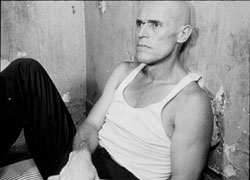 The movie was directed by Steve Buscemi, who’s credo as a storyteller appears to be all about restraint, which worked wonders for his first feature, Trees Lounge (a personal favorite and actually the reason I went to see this one). Here, however, Buscemi’s thoughtful under-directing actually works against the interest of the material, which desperately needs to be juiced up.
The movie was directed by Steve Buscemi, who’s credo as a storyteller appears to be all about restraint, which worked wonders for his first feature, Trees Lounge (a personal favorite and actually the reason I went to see this one). Here, however, Buscemi’s thoughtful under-directing actually works against the interest of the material, which desperately needs to be juiced up.
The most energizing aspect of the movie comes from Micky Rourke, who plays Ron’s first cell-mate – a transvestite blabbermouth, who’s so over the top that during his few minutes of screen time, things not only start to feel anesthetically balanced but wild and gritty and foolish. If the movie had just been a one-man monologue by Rourke, it probably would have been unbeatable.
Handling is also one of the main problems with Denys Arcand’s new film, Stardom.
Jessica Paré plays Tina Menzhal, a townie from the wastelands of central Canada who is “discovered” one afternoon when a freelance photographer snaps her picture while she’s playing hockey. The rest of the movie charts the course of her sudden ignition in the world of modeling, which soon leads to supermodeldom, which then leads to several bad marriages and suddenly and abruptly ends, leaving her essentially back where she started, but supposedly wiser (though it’s hard to say – this is the sort of movie in which ambiguity is played as class).
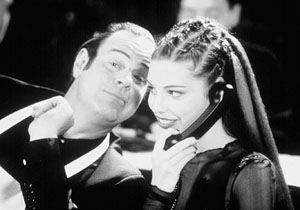 The gimmick which separates this movie from its Jacquelline Susann plotline is that, with the exception of the short bookends, the whole story is told through the various eyes of the media fixated upon Tina, i.e. we only see her through various video feed from TV gossip shows, MTV-style “news shows,” and documentary footage taken by fashion photographer Bruce Taylor (Robert Lepage doing a great eyebrow-free cut-up on Bruce Conner). This angle makes the movie not just a satire on the whole fashion scene, but on the sycophantic world of the mass media and the symbiotic nature of exploitation which we as viewers are very much actively engaged in.
The gimmick which separates this movie from its Jacquelline Susann plotline is that, with the exception of the short bookends, the whole story is told through the various eyes of the media fixated upon Tina, i.e. we only see her through various video feed from TV gossip shows, MTV-style “news shows,” and documentary footage taken by fashion photographer Bruce Taylor (Robert Lepage doing a great eyebrow-free cut-up on Bruce Conner). This angle makes the movie not just a satire on the whole fashion scene, but on the sycophantic world of the mass media and the symbiotic nature of exploitation which we as viewers are very much actively engaged in.
Jessica Paré is absolutely amazing, and if she wasn’t, the whole works would’ve jammed up and fallen apart early on, seeing as she’s in virtually every frame of the movie and needs to provide the emotional gravity to all the antics. The fact that this young lady isn’t the best actress only adds to her character’s authenticity – someone with more learned timing wouldn’t have felt as real, and since the Tina character is played very adroitly as not-at-all-next-year’s-candidate-for-the-McArthur-fellowship, the aura of nonprofessional clumsiness Paré layers onto those immaculate eyes and honey-kissed lips holds things together very well.
Unfortunately, Denys Arcand didn’t follow his leading lady’s lead and mucks things up, killing much of what could be powerful and successful in this movie by over-calculating his directing and underwriting his story, so that despite Paré’s magnesium-like presence, the story unfolds in the most predictable way possible, always taking the easiest shots at both fashion and the media. This misfire might’ve occurred because Arcand tried to keep the material classy, as in highbrow, as in soft – the sort of thing where you chuckle at the jokes and glance over at the person next to you instead of laughing out loud. This approach, which worked so well in his other movies, especially Love and Human Remains, never catches on here simply because his angle on the media and fashion, as well as these beasts themselves, are just not classy. Avoiding any explicitness (no drug use, no weird sexual bullshit, nothing really gross) makes his narrative come off not as smug and insightful, but old-fashioned and frumpy.
Another mistake Arcand makes is to shoot the movie in film even though most of it supposed to be told in video. He justifies this transition with a gimmick early on, but it doesn’t hold. I understand his not wanting to go the Oliver Stone direction of too many different formats which just end up calling attention to themselves to the point of invading the story, but at the same time, I spent most of the picture thinking about this problem anyway. What I was watching didn’t look right, and then in the middle, for some reason, Arcand breaks his own rule and throws in some video footage from a public access stalkerazzi show. Arcand does manage to pull the best performance out of Dan Akroyd (playing a philandering restraunteur) this side of My Girl and there’s something to be said for that.
Arcand would have learned a lot by reviewing the back catalog of master Philip Kaufman (especially Henry and June and The Unbearable Lightness of Being), an artist who knows how to perfectly balance the juicy necessity of smut with the power of literate storytelling, and while his new flick, Quills, might not be the art of his past, it’s a lot closer than anything else I’ve seen in the last two years.
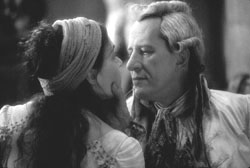 The story is basic (written by fancy theater phoneme Doug Wright, based on his play): It’s the last months of the Marquis de Sade’s life as he writes pornography in an insane asylum and is encouraged by a pretty-boy priest, played by Joaquin Phoenix, whose work gets smuggled out by a smitten laundress, played by Kate Winselt, who is ultimately squashed and killed by the bad man psychiatrist, played by Michael Caine.
The story is basic (written by fancy theater phoneme Doug Wright, based on his play): It’s the last months of the Marquis de Sade’s life as he writes pornography in an insane asylum and is encouraged by a pretty-boy priest, played by Joaquin Phoenix, whose work gets smuggled out by a smitten laundress, played by Kate Winselt, who is ultimately squashed and killed by the bad man psychiatrist, played by Michael Caine.
Without an ounce of subtly, this is a story about art, pornography, their power beyond good and evil, and how expression is ultimately a mandate over anything else, even though our society seems hell-bent on stifling it in all forms.
Quills works much better than Stardom (though Stardom never for a moment takes its subject seriously enough to consider her as art – another failing) because Kaufman is probably one of the only filmmakers working today other than David Lynch or Matthew Bright who understands that if you’re making a flick about or relating to smut, you must also be smutty in your filmmaking to a certain degree. There’s no way to stand outside and poke around, as Arcand tries to do.
Quills is your best bet for high art that you’ll watch without feeling bored (except for the very end). What keeps it from being a masterpiece are three things: 1) The script by Doug Wright is completely overwritten. I’m not sure of the changes he made to his play, or how this might’ve looked on stage, but the affectation given to the dialogue kills basically everyone except for the always astounding Kate Winslet and equally fantastic Michael Caine. Wright is clearly lacking a point of view to hang his story on, and there’s much floundering as a result, all of which leads to at least three endings, two of which (compromising about thirty or forty minutes) could be chopped off without doing any discredit to either the story or the “message” Wright hammers at us. 2) Joaquin Phoenix is completely miscast as the priest, looking like something out of an early Derek Jarmin effort and never once believable for the situation or time period. 3) Geoffrey Rush, who I really liked in the otherwise completely forgettable Elizabeth, completely blows it as de Sade, sometimes playing him hammy, sometimes crazy, sometimes self-consciously artistic and troubled, with none of these little bits ever adding into anything fluid or compelling or even competent. The scenes he shares with Phoenix – what with the stagy and preachy dialogue both have to suffer – are devastating. These are the times the movie just shuts down. Luckily, Philip Kaufman is one of the true geniuses of current cinema and keeps things somewhat balanced, or at least enough for me.
Darren Aronofsky proved he had some insight when he made Pi, because he used ultra-independent guerrilla filmmaking materials and mixed them with hip music video style to come up with that movie and ended up fooling most of generation dumb-ass and the independent snobs as a result. No small feat.
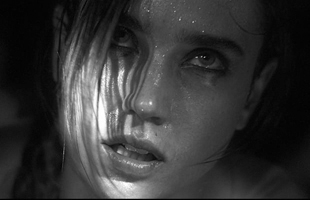 With Requiem for a Dream he proves that he has no further tricks up his sleeve, as well as none of the talent to actually produce a good movie.
With Requiem for a Dream he proves that he has no further tricks up his sleeve, as well as none of the talent to actually produce a good movie.
Requiem is your better basic just-say-oh-no-to-drugs movie. There aren’t any characters, just representations. There’s the representation of the loser wanna-be boy, the representation of his girlfriend, and Negro buddy, and his Jewish mother. Everyone does drugs and everyone suffers.
It’s all based on an actually fantastic book by Hubert Selby Jr.. What makes the book so great isn’t so much the story but the style that Selby employs writing it. It ends up becoming not only the central character, but the environment as well.
Aronofsky utilizes three rip-off gimmicks in an attempt to mimic this style: split screen (championed by DePalma), whatever you call that thing when you stick a camera on someone so their shoulders become the horizon line (championed by Scorcese), sped-up, slowed-up motion (championed by who cares) and ultra-tight close-ups (I’m not sure who championed this, but I remember Tarentino in his last two using them a lot). All of these tricks make the first 39 minutes or so interesting and sometimes engaging, but by the second and third act when Aronofsky attempts to show the repetitive hell of drug use by repetition and reductionism of narrative, everything becomes first boring and then silly. Since there’s no story and no characters, Aronofsky can only try to be really disgusting and wild for his grand finally. I’m sure many 14-year-olds will be impressed with the results.
There’s only one and a half reasons to see this film: The half is the song Aronofsky somehow got from Kronos Quartet, which he then kills by playing it too many times, and the one is Jennifer Connally who’s probably a better actress than Kate Winslet, only hasn’t gotten a role yet to prove it. And the best thing about Connally in this movie – what makes her so incredibly sexy – are her unplucked eyebrows. Don’t ask me why. You take what you can get, and they’re reason enough to suffer through the rest.

